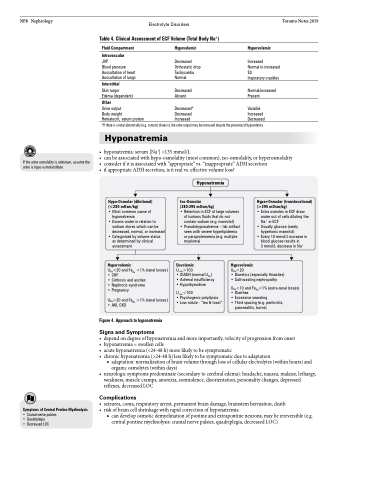Page 708 - TNFlipTest
P. 708
NP8 Nephrology
Electrolyte Disorders
Toronto Notes 2019
Table 4. Clinical Assessment of ECF Volume (Total Body Na+)
Fluid Compartment
Intravascular
JVP
Blood pressure Auscultation of heart Auscultation of lungs
Interstitial
Skin turgor
Edema (dependent)
Other
Urine output
Body weight
Hematocrit, serum protein
Hypovolemic
Decreased Orthostatic drop Tachycardia Normal
Decreased Absent
Decreased* Decreased Increased
Hypervolemic
Increased
Normal to increased S3
Inspiratory crackles
Normal/increased Present
Variable Increased Decreased
If the urine osmolality is unknown, assume the urine is hypo-osmolar/dilute
*If there is a renal abnormality (e.g. osmotic diuresis), the urine output may be increased despite the presence of hypovolemia
Hyponatremia
• hyponatremia:serum[Na+]<135mmol/L
• canbeassociatedwithhypo-osmolality(mostcommon),iso-osmolality,orhyperosmolality • considerifitisassociatedwith“appropriate”vs.“inappropriate”ADHsecretion
• ifappropriateADHsecretion,isitrealvs.effectivevolumeloss?
Hypo-Osmolar (dilutional) (<280 mOsm/kg)
• Most common cause of
hyponatremia
• Excess water in relation to
sodium stores which can be
decreased, normal, or increased
• Categorized by volume status
as determined by clinical assessment
Hypervolemic
UNa<20 and FeNa <1% (renal losses) • CHF
• Cirrhosis and ascites
• Nephrotic syndrome
• Pregnancy
UNa>20 and FeNa >1% (renal losses) • AKI, CKD
Figure 4. Approach to hyponatremia
Signs and Symptoms
Hyponatremia
Iso-Osmolar
(280-295 mOsm/kg)
• Retention in ECF of large volumes
Hyper-Osmolar (translocational) (>295 mOsm/kg)
• Extra osmoles in ECF draw
water out of cells diluting the
Na+ in ECF
• Usually glucose (rarely
hypertonic mannitol)
• Every 10 mmol/L increase in
blood glucose results in
3 mmol/L decrease in Na+
•
of isotonic fluids that do not contain sodium (e.g. mannitol) Pseudohyponatremia – lab artifact seen with severe hyperlipidemia or paraproteinemia (e.g. multiple myeloma)
Euvolemic
Uosm>100
• SIADH (normal UNa) • Adrenal insufficiency • Hypothyroidism
Uosm<100
• Psychogenic polydipsia
• Low solute - “tea & toast”
Hypovolemic
UNa>20
• Diuretics (especially thiazides) • Salt-wasting nephropathy
UNa<10 and FeNa<1% (extra-renal losses) • Diarrhea
• Excessive sweating
• Third spacing (e.g. peritonitis,
pancreatitis, burns)
Symptoms of Central Pontine Myelinolysis
• Cranial nerve palsies • Quadriplegia
• Decreased LOC
• dependondegreeofhyponatremiaandmoreimportantly,velocityofprogressionfromonset • hyponatremia=swollencells
• acutehyponatremia(<24-48h)morelikelytobesymptomatic
• chronichyponatremia(>24-48h)lesslikelytobesymptomaticduetoadaptation
■ adaptation: normalization of brain volume through loss of cellular electrolytes (within hours) and organic osmolytes (within days)
• neurologicsymptomspredominate(secondarytocerebraledema):headache,nausea,malaise,lethargy, weakness, muscle cramps, anorexia, somnolence, disorientation, personality changes, depressed reflexes, decreased LOC
Complications
• seizures,coma,respiratoryarrest,permanentbraindamage,brainstemherniation,death • riskofbraincellshrinkagewithrapidcorrectionofhyponatremia
■ can develop osmotic demyelination of pontine and extrapontine neurons; may be irreversible (e.g. central pontine myelinolysis: cranial nerve palsies, quadriplegia, decreased LOC)


